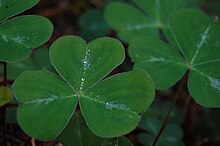Shamrock: Difference between revisions
rv further |
No edit summary |
||
| Line 4: | Line 4: | ||
[[Image:Shamrock leaf.jpg|thumb|220px|[[Common wood sorrel|Oxalis acetosella]]]] |
[[Image:Shamrock leaf.jpg|thumb|220px|[[Common wood sorrel|Oxalis acetosella]]]] |
||
The '''shamrock''' ({{unicode|♣}}) is a symbol of [[Ireland]]. It is a '''three-leafed old white clover'''. The name ''shamrock'' is derived from [[Irish language|Irish]] ''{{lang|ga|seamróg}}'', which is the [[diminutive]] version of the Irish word for [[clover]] (''{{lang|ga|seamair}}''). |
The '''shamrock''' ({{unicode|♣}}) is a symbol of [[Ireland]]. It is a '''three-leafed old white clover'''. Shamrocks are Green. The name ''shamrock'' is derived from [[Irish language|Irish]] ''{{lang|ga|seamróg}}'', which is the [[diminutive]] version of the Irish word for [[clover]] (''{{lang|ga|seamair}}''). |
||
It is sometimes of the variety {{lang|la|''[[Trifolium repens]]''}} (white clover, Irish: {{lang|ga|''seamair bhán''}}) but today usually {{lang|la|''[[Trifolium dubium]]''}} (lesser clover, Irish: {{lang|ga|''seamair bhuí''}}). However, other three-leafed plants—such as {{lang|la|''[[Medicago lupulina]]''}}, {{lang|la|''[[Trifolium pratense]]''}}, and {{lang|la|''[[Oxalis]]''}}—are sometimes designated as shamrocks. The shamrock was traditionally used for its [[Herbalism|medical]] properties and was a popular [[Motif (visual arts)|motif]] in [[Victorian era|Victorian]] times. |
It is sometimes of the variety {{lang|la|''[[Trifolium repens]]''}} (white clover, Irish: {{lang|ga|''seamair bhán''}}) but today usually {{lang|la|''[[Trifolium dubium]]''}} (lesser clover, Irish: {{lang|ga|''seamair bhuí''}}). However, other three-leafed plants—such as {{lang|la|''[[Medicago lupulina]]''}}, {{lang|la|''[[Trifolium pratense]]''}}, and {{lang|la|''[[Oxalis]]''}}—are sometimes designated as shamrocks. The shamrock was traditionally used for its [[Herbalism|medical]] properties and was a popular [[Motif (visual arts)|motif]] in [[Victorian era|Victorian]] times. |
||
Revision as of 18:37, 26 March 2011


The shamrock (♣) is a symbol of Ireland. It is a three-leafed old white clover. Shamrocks are Green. The name shamrock is derived from Irish seamróg, which is the diminutive version of the Irish word for clover (seamair).
It is sometimes of the variety [Trifolium repens] Error: {{Lang}}: text has italic markup (help) (white clover, Irish: [seamair bhán] Error: {{Lang}}: text has italic markup (help)) but today usually [Trifolium dubium] Error: {{Lang}}: text has italic markup (help) (lesser clover, Irish: [seamair bhuí] Error: {{Lang}}: text has italic markup (help)). However, other three-leafed plants—such as [Medicago lupulina] Error: {{Lang}}: text has italic markup (help), [Trifolium pratense] Error: {{Lang}}: text has italic markup (help), and [Oxalis] Error: {{Lang}}: text has italic markup (help)—are sometimes designated as shamrocks. The shamrock was traditionally used for its medical properties and was a popular motif in Victorian times.
Badge of Ireland
History
According to what the Oxford English Dictionary calls "a late tradition" (first recorded in 1726), the plant was used by Saint Patrick to illustrate the Christian doctrine of the Trinity. However, the posthumous timing of this legend (coming some 1,200 years after his death), and the lack of supporting evidence found in St. Patrick's writings have caused some to question its authenticity.[1] In the pre-Christian era Celtic moon cult the shamrock symbolised the three phases of the moon [2]
Modern usage

The shamrock has been registered as a trademark by the Government of Ireland.[3] It is also informally used as an emblem for sports teams and state organisations within Ireland: the IRFU, Shamrock Rovers F.C., IDA Ireland, University College Dublin and Fáilte Ireland use it as part of their identity.
In Northern Ireland, it is also used by the Northern Ireland Tourist Board and is included on the Coat of Arms of the United Kingdom. Additionally, former Formula 1 racing driver Eddie Irvine included a shamrock on the back of his helmet and the shamrock is part of the uniform of the Royal Irish Regiment. The shamrock forms a major constituent of the team badge for football team Cliftonville F.C., similar to the the badge of Celtic F.C. The shamrock, and variously the Flax plant, is also a symbol of Northern Ireland.
Outside Ireland, various organisations, businesses and places use the symbol to advertise a connection with the island. Basketball team, the Boston Celtics in the USA incorporate the shamrock in their logos and the US cereal Lucky Charms uses it on the product's mascot and as a shape in the cereal itself.
Traditionally in Ireland, and in many places throughout the world, the shamrock is worn on the lapel on St Patrick's Day.
Other uses


- The shamrock signified the First Division of the Second Corps of the Army of the Potomac in the American Civil War, which contained the Irish Brigade. It was red as were all of the division insignia of that corps and still be seen on the regimental coat of arms of "The Fighting Sixty-Ninth"
- The flag of the city of Montreal, Quebec, Canada has a shamrock that is located in the lower right quadrant. The shamrock represents the Irish population, one of the four major ethnic groups that made up the population of the city in the 19th century when the arms were designed.
- The shamrock is featured in Canadian Coat of arms, at the bottom
- The shamrock is featured on the passport stamp of Montserrat, many of whose citizens are of Irish descent.
- The airline Aer Lingus uses the emblem in its logos, and its air traffic control call sign is "SHAMROCK".
- The Erin Go Bragh flag, originally of Saint Patrick's Battalion, uses an angelic Cláirseach, a medieval Irish harp, cradled in a wreath of clover. A flag strongly symbolic of Irish nationalism, it is often seen on Saint Patrick's Day, usually displayed during the parades.* Soldiers of the Royal Irish Regiment of the British army use the shamrock as their emblem, and wear a sprig of shamrock on Saint Patrick's Day. Shamrock are exported to wherever the regiment is stationed throughout the world. Queen Victoria decreed over a hundred years ago that soldiers from Ireland should wear a sprig of shamrock in recognition of fellow Irish soldiers who had fought bravely in the Boer War, a tradition continued by British army soldiers from both the north and the south of Ireland following partition in 1921.
- The coat of arms on the flag of the Royal Ulster Constabulary George Cross Foundation was cradled in a wreath of shamrock.[4]
- The shamrock is featured on the crest of Shamrock Rovers.
- During the Russian Civil War a British officer Col. P.J. Woods, of Belfast, established a Karelian Regiment which had a shamrock on an orange field as its regimental badge.
- The Danish football club Viborg FF uses a shamrock in its badge and it has become a symbol of the town Viborg.
- The shamrock is also featured on the badges of Panathinaikos and AC Omonia.
- The shamrock is among the symbols of the Aryan Brotherhood, a prison gang.
Four-leaf clover
The four-leaf clover is often confused with the shamrock. While the four-leaf clover is a symbol of good luck, the three-leafed shamrock is mainly an Irish Christian symbol of the Holy Trinity and has a different significance.[5]
See also
Notes
- ^ Saint pat used the shamrock to illustrate the holy trinity at De-fact-o.com - "Untangling The Web One Fact At A Time"
- ^ http://www.2020site.org/history/celtic-trinity-symbol.html
- ^ Use of the harp and the shamrock were registered by the Irish government as international trademarks. See Record of the meeting of the Joint Oireachtas Committee on Enterprise and Small Business, 26 March 2003. Retrieved 2008-07-20.
- ^ College of Arms Newsletter, August 2004
- ^ Saint Patrick used the shamrock to illustrate the holy trinity at De-fact-o.com - "Untangling The Web One Fact At A Time"
References
- Nelson, E. Charles; Loughin, Bernard (1991). Shamrock: Botany and History of an Irish Myth: A Biography of the Shamrock in History, Literature, Music and Art. Boethius Press. ISBN 0-86314-199-4.
External links
- The Shamrock : A Further attempt to fix its species, by Nathaniel Colgan, published in the Irish Naturalist 1893 on the From Ireland web site. Retrieved 2008-07-20
- The truth behind the shamrock on the BBC News website, dated 17 March 2004. Retrieved 2008-07-20
- Landscaping: Shamrocks and 4-Leaf Clovers on the About.com website. Retrieved 2008-07-20
- www.decodeunicode.org/en/u+2618 Shamrock as a symbol in Unicode
